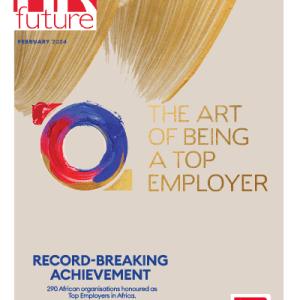Strategically connecting human resources decisions to the rest of the business sounds like a no-brainer, but businesses still struggle to break down the silos of HR and business operations.
Imagine asking a CFO to invest 40% of their company’s annual operating budget on a project where the only ROI is summed up as “most employees don’t quit or complain.” That’s the state of a lot of companies when it comes to understanding the precise financial value generated by money spent on human resources (HR) activities, including benefits and payroll.
It’s not that leaders don’t recognize or appreciate the value of employees. The trouble is that organizations struggle to determine the value generated by investments in people. Everyone agrees that companies must invest money to reward and develop employees. But how much is the right amount? And, faced with limited funds, is it better to invest in training, compensation, benefits, or office technology? While employees are among the largest operating expenses for most organizations, leaders haven’t been able to fully understand the impact people have on business performance – and make changes for the better. This is slowly but surely changing.
Dave Ulrich, professor at the Ross School of Business at the University of Michigan and partner at The RBL Group, pioneered a Digital HR framework that divided HR’s use of technology into four evolutionary phases. He said that companies are beginning to pilot programs that go beyond just measuring HR activities.
“There’s been descriptive work to define best practices in places like hiring or even leadership qualities, but top HR leaders are evolving towards rigorous and thoughtful prescriptive work to define what HR initiatives will have the most business impact,” he said. “Through our pilot research on an Organization Guidance System, we now think HR can provide their organizations with data-based insights to optimize investments in people and organization to deliver the outcomes the business cares about.”
In fact, companies worldwide are modernizing both HR and the entire organization to become intelligent enterprises. They are driving significant business results by closing the gap between workforce management practices and business operations.
Redefine HR’s value
Strategically connecting HR decisions to the rest of the business sounds like a no-brainer. After all, the goal of what’s become known as human experience management (HXM) is to build a workforce that successfully delivers business results. But most ROI calculations still focus on workforce metrics such as time to hire, employee engagement, or workforce turnover. Metrics like employee engagement and turnover impact business results, but are not equivalent to business results. Companies do not pay people to be engaged and not quit. Companies pay people to drive business outcomes like sales, customer satisfaction, operational efficiency, and on-time product delivery.
Measuring the wrong things is not due to lack of data. The problem is HR cannot easily access the data that business leaders care most about because it is not kept in HR technology systems. Financial performance, operational efficiency, and customer service information is not only stored in separate systems, but also structured in different ways. Sure, HR can conduct pulse surveys to see how employees feel about compensation, development, or recruitment practices. But to understand the real business impact of people, leaders must measure business outcomes linked to employees and show how they relate to investments in salary, benefits, training, and other employment costs associated.
HR leaders cannot easily access the data that business operations leaders care most about because it’s kept in non-HR technology systems.
Translate HR into business language
The disconnect between operations and HR goes far beyond technology. According to Dr. John Boudreau, senior research scientist with the Center for Effective Organizations at the University of Southern California, leaders need to stop thinking about talent only in terms of HR activities or expenses. Business leaders can better understand the value of talent once it’s translated it into the context and language of their specific operations.
“Working with a supply chain engineer, I’d ask them to think about the flow of talent into and through their organization in the same way they would consider the flow of any resource they required,” said Boudreau. “Suddenly they could see how to manage a talent pipeline to achieve their business objectives. The employee experience would be retooled through a consumer marketing lens. The issue of talent risk would be retooled through a financial diversification lens, and so forth. HR leaders can engage other functional leaders by presenting talent decisions in functionally-specific ways.”
As simple as this concept sounds, Boudreau acknowledged that it requires HR to fundamentally rethink the function itself, as well as how it operates throughout the organization.
“Every business function adds value in different ways. It’s clear how HR adds value when it comes to compliance and control, or services like recruitment and development. But this reinforces HR’s value as a set of activities,” he said. “Companies can strengthen the connection between HR and the business by providing a decision framework that makes leaders smarter about how they define, track, and manage internal rate of return on their talent investment. That’s what makes the finance discipline so powerful and effective.”
Boudreau added that technology can help hold leaders accountable for their talent-related decisions.
Case studies showcase the possible
A recent internal project at SAP identified over 20 customer case studies that illustrate the benefits of linking HR data and systems to business and financial systems. The business outcomes were profound:
- Calculating the ROI of increasing call center compensation levels by determining the relationship between pay, employee commitment, and customer sales levels.
- Coordinating retail supply chain solutions with HR learning systems so frontline employees automatically received training on new products before shipment to stores.
- Linking physical security systems to HR systems so employee access to work locations was automatically turned on or off based on real-time employment and qualification status.
- Integrating data on manager skills, employee experience, and sales performance to determine which manager training programs had the greatest impact on sales team revenue generation.
- Analyzing data on the size, skills, and productivity of development teams to determine how organizational structure affected new product innovation.
- Calculating the value of providing employees with consistent work schedules, factoring in the cost of over-staffing against increased customer sales and service levels from a stable and committed workforce.
Most striking about these examples was their conceptual simplicity. Their value was often so obvious it needed no explanation. What store manager couldn’t see the advantage of understanding the ROI of workforce scheduling based on its impact on employee productivity, customer loyalty, and profitability? What company wouldn’t want to lower the risk of security breaches by tying HR data to an employee’s facility access? Yet, examples demonstrating the value of linking HR and business operations data remain the exception, not the rule. What’s more, companies that have made this link typically had only a few examples of when they had actually done it. Which makes one wonder: why aren’t more companies aren’t doing it? Two main barriers stand in the way: technology interoperability and long-held business principles.
Replace comfortable silos with connected business value
A historical lack of interoperability between company technology systems has created a divide between HR and business operations in many organizations. Interoperability involves much more than simply passing data between systems. Companies need the tools to maintain and coordinate how data is organized, secured, stored, and analyzed. People need easier ways to link data from HR, financial, and operational systems, factoring in differences in how information might be organized. Data links and analytics must be automatically updated when informational systems and structures change. Systems need to be designed with common user interfaces and security access controls, allowing employees to effectively and safely move between different technology solutions.
Admittedly complex, interoperability is beyond the technical expertise of most HR professionals and business leaders. But it has profound implications for the relationship between HR and business operations. The way HR and business leaders view intelligent enterprise technology might be likened to homeowners watching workers lay optical fiber cables beneath their neighborhood roads. Homeowners may not understand the technology behind what these workers are doing. But they immediately understand its value when their home internet runs exponentially faster. Similarly, HR and business leaders may not understand the intelligent enterprise or the complexities of interoperability. But they will appreciate the impact it has on their ability to use HR methods to drive business results.
Rewrite cultural and leadership norms
The wall between HR and the rest of the business can be profound. For example, too many conversations – even from senior leaders at major companies – often talk about strategies, finances, and technology without mentioning people. To become an intelligent enterprise that brings previously disconnected HR and ERP and finance silos together, leaders have to also rethink the relationship between HR processes and business operations.
To understand the real business impact of people such as profitability, growth, customer service, and safety, leaders have to measure how their investments in people pay off in business outcomes.
- HR leaders need to admit what they do not know, namely the data that reveals how employees contribute to profit, growth, efficiency, brand image, and customer satisfaction. Remember, companies do not pay employees to be engaged. They pay people because they believe the contributions employees make to the organization outweigh the cost of employing them. These contributions typically involve things that HR systems do not measure or track. Partnering with IT and business operations, HR can bring this data together so everyone understands the true business value of employees and can make more informed decisions.
- Business leaders must embrace the value of HR data. The capabilities, commitment, and performance of employees are no longer peripheral to business as usual. People are critical to business growth against an onslaught of market uncertainty and rapid disruption. To unlock the full value of employees to help drive stronger results, business leaders need a serious attitude adjustment. Just as business gurus embraced the importance of total quality management data in the 1980s, customer service data in 1990s, and time-to-market data in the early aughts, leaders need a similar mindset shift that recognizes the importance of applying HR data to help guide business decisions.
- IT leaders need to challenge internal stakeholders, whether from HR, finance or other business operations, to actively collaborate, creating solutions that break down company silos. IT can educate the company that, with the advent of in-memory cloud-based systems (such as SAP S/4 HANA), previously disjointed and isolated processes due to technological constraints no longer exist.
Imagine something that’s never existed
Many transformational technologies are difficult to understand when they first appear. Thirty years ago, no one could have comprehended how cloud-based platforms would change business and life. More recent examples would be digital twins or blockchain. Similarly, intelligent enterprise technology is unbelievably transformative – but most people have no idea to what degree because it never existed before. The intelligent enterprise doesn’t just automate what companies already have. It creates brand new connections for business value that weren’t possible until now.
- HR leaders need to admit what they do not know, namely the data that reveals how employees contribute to profit, growth, efficiency, brand image, and customer satisfaction. Remember, companies do not pay employees to be engaged. They pay people because they believe the contributions employees make to the organization outweigh the cost of employing them. These contributions typically involve things that HR systems do not measure or track. Partnering with IT and business operations, HR can bring this data together so everyone understands the true business value of employees and can make more informed decisions.
- Business leaders must embrace the value of HR data. The capabilities, commitment, and performance of employees are no longer peripheral to business as usual. People are critical to business growth against an onslaught of market uncertainty and rapid disruption. To unlock the full value of employees to help drive stronger results, business leaders need a serious attitude adjustment. Just as business gurus embraced the importance of total quality management data in the 1980s, customer service data in 1990s, and time-to-market data in the early aughts, leaders need a similar mindset shift that recognizes the importance of applying HR data to help guide business decisions.
- IT leaders need to challenge internal stakeholders, whether from HR, finance or other business operations, to actively collaborate, creating solutions that break down company silos. IT can educate the company that, with the advent of in-memory cloud-based systems (such as SAP S/4 HANA), previously disjointed and isolated processes due to technological constraints no longer exist.
Imagine something that’s never existed
Many transformational technologies are difficult to understand when they first appear. Thirty years ago, no one could have comprehended how cloud-based platforms would change business and life. More recent examples would be digital twins or blockchain. Similarly, intelligent enterprise technology is unbelievably transformative – but most people have no idea to what degree because it never existed before. The intelligent enterprise doesn’t just automate what companies already have. It creates brand new connections for business value that weren’t possible until now.















